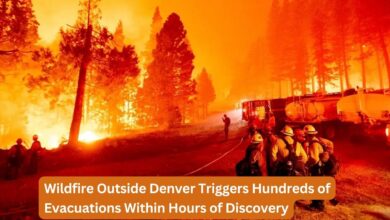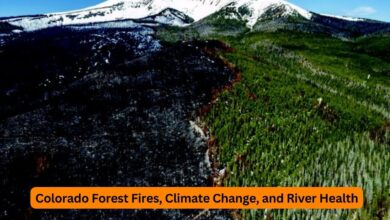Fires in Colorado Today: A Comprehensive Update on the Current Wildfires

Introduction
Fires in Colorado today have become a significant concern for residents, emergency services, and environmentalists. Wildfires are a natural part of the ecosystem in Colorado, but recent years have seen an increase in their frequency and intensity, largely due to climate change and human activity. This article provides a comprehensive update on the current wildfires in Colorado, including their locations, impacts, and the efforts being made to control them.
Overview of the Current Situation
The Scale of the Fires
As of today, multiple wildfires are burning across Colorado, affecting thousands of acres of land. These fires are primarily located in forested areas but have also spread to grasslands and residential areas, posing a significant threat to homes and infrastructure.
Key Areas Affected
The most significant fires currently burning in Colorado are:
- Cameron Peak Fire: Located in the Arapaho and Roosevelt National Forests, this fire has consumed over 200,000 acres and is still spreading.
- East Troublesome Fire: This fire has burned over 100,000 acres in Grand County and has forced the evacuation of several communities.
- CalWood Fire: Situated in Boulder County, this fire has burned around 10,000 acres and is threatening residential areas.
Causes of the Fires
The primary causes of these wildfires are a combination of natural and human factors. Prolonged drought conditions, high temperatures, and strong winds have created an environment ripe for wildfires. Additionally, human activities such as unattended campfires, fireworks, and arson have contributed to the ignition and spread of these fires.
Impact on Communities and Environment
Evacuations and Displacement
Thousands of residents have been evacuated from their homes as a result of the wildfires. Emergency shelters have been set up to accommodate those displaced, but the process of evacuation is stressful and challenging, especially for vulnerable populations such as the elderly and those with disabilities.
Air Quality and Health Concerns
The smoke from the wildfires has significantly deteriorated air quality in Colorado and surrounding states. Fine particulate matter in the smoke poses serious health risks, particularly for individuals with respiratory conditions, children, and the elderly. Authorities have issued air quality advisories, urging people to stay indoors and use air purifiers if possible.
Destruction of Property
The wildfires have destroyed numerous homes, businesses, and other structures. The financial impact on affected families and communities is immense, with many facing the daunting task of rebuilding their lives and properties from scratch.
Environmental Impact
The environmental impact of the wildfires is profound. Forest ecosystems, which take decades to mature, are being decimated. Wildlife habitats are being destroyed, leading to the displacement and death of countless animals. The fires also contribute to soil erosion and degrade water quality in nearby streams and rivers.
Firefighting Efforts and Challenges
Resources Deployed
A massive effort is underway to combat the wildfires in Colorado. Thousands of firefighters from local, state, and federal agencies have been deployed. Firefighting aircraft, including helicopters and air tankers, are being used to drop water and fire retardant on the blazes.
Strategies and Techniques
Firefighters are using a combination of direct and indirect firefighting techniques. Direct methods include creating firebreaks and attacking the fire’s edge, while indirect methods involve setting controlled burns to remove potential fuel sources ahead of the fire’s path.
Challenges Faced
Firefighting efforts are being hampered by several challenges:
- Weather Conditions: High winds and dry conditions make it difficult to contain the fires and can cause them to spread rapidly.
- Terrain: The rugged terrain of Colorado’s forests and mountains makes it challenging for firefighters to access and combat the fires.
- Resource Availability: Despite the large-scale deployment, there is a constant need for more resources, including personnel, equipment, and funding.
Community and Government Response
Evacuation Plans and Shelters
Local governments have implemented comprehensive evacuation plans to ensure the safety of residents. Shelters have been established in community centers, schools, and churches, providing displaced individuals with a place to stay, food, and medical assistance.
Support and Relief Efforts
Nonprofit organizations, charities, and local businesses have stepped up to provide support to those affected by the wildfires. Donations of food, clothing, and other essentials are being collected and distributed. Financial assistance programs are also being set up to help families rebuild.
Government Action
State and federal governments are working closely to coordinate the response to the wildfires. This includes deploying resources, providing financial aid, and supporting firefighting efforts. Colorado’s governor has declared a state of emergency, which allows for the rapid mobilization of resources and assistance from neighboring states.
Preventative Measures and Future Outlook
Fire Prevention Campaigns
Efforts are being made to educate the public about fire prevention. Campaigns focus on responsible behavior, such as properly extinguishing campfires, adhering to fire bans, and reporting suspicious activities that could lead to fires.
Forest Management Practices
Improved forest management practices are being implemented to reduce the risk of wildfires. This includes controlled burns to clear out underbrush, thinning dense forest areas, and creating firebreaks to slow the spread of fires.
Climate Change Mitigation
Addressing the underlying issue of climate change is critical in the fight against wildfires. Reducing greenhouse gas emissions, promoting sustainable practices, and investing in renewable energy are essential steps in mitigating the long-term impact of climate change on wildfire frequency and intensity.
Technological Advancements
Advancements in technology are also playing a role in wildfire prevention and response. Drones are being used for aerial surveillance, providing real-time data on fire spread and intensity. Early warning systems and predictive modeling are helping authorities to anticipate and prepare for potential fire outbreaks.
Conclusion
The fires in Colorado today are a stark reminder of the increasing threat posed by wildfires in the face of climate change and human activity. The impact on communities, the environment, and the economy is profound, necessitating a coordinated and sustained response from all levels of society. As firefighting efforts continue, it is crucial to focus on both immediate relief and long-term prevention strategies to safeguard Colorado’s residents and natural landscapes from future wildfire disasters.




